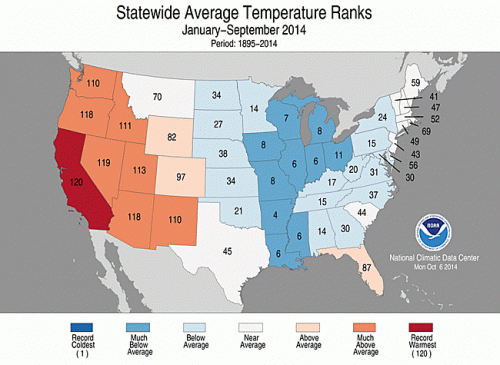News•November 5, 2014
2014 Will Go Down As Hottest In California’s History
Book it: This year will go down as the hottest in California’s history.
With just two months left in the year, there’s a better than 99 percent chance that 2014 will be the warmest year on record for California, according to National Weather Service meteorologists.
Temperature rankings by state through September.
Credit: National Climatic Data Center

The state has been baking in above-average temperatures all year — setting a record for the warmest first six months of any year this June — thanks to a persistent atmospheric pattern that has also mired California in a major drought. The heat has only exacerbated the drought’s effects, and the state is in dire need of a really wet winter, an uncertain prospect right now.
The year is also on pace to be the warmest on record globally, edging out 2010 thanks to large pockets of warmth in the oceans. Nine of the 10 warmest years on record have occurred in the 21st century, a mark of the steady climb of Earth’s average temperatures as greenhouse gases increasingly accumulate in the atmosphere.
Consistent warmth
The NWS office in Hanford, Calif., tweeted a graphic on Monday that showed the likely scenarios for how the average temperature of the year would play out. Based on observed temperatures, and the climatological history of the last two months of the year for the state, there is a better than 99 percent chance that 2014 will easily top 1934 as California’s warmest on record, going back to 1895.RELATEDCalif. Heads for Warmest Year As Drought Hangs On
Where Is El Nino? And Why Do We Care?
Hints of Climate Change in California’s Drought
“It’s going to be pretty far above it,” said Paul Iniguez, the science operations officer for the Hanford office.
The average temperature for 1934 was 59.7°F (an anomalously high temperature compared to other years at that time), and it’s looking like 2014 could hit around 61°F, Iniguez told Climate Central.
The driver of California’s hot year hasn’t been a succession of heat waves like in previous warm years. Instead, “it’s just been very consistently warm throughout the year,” Iniguez said. “We started really warm and it just never” went away.
The reason for the perpetual warmth is a persistent atmospheric ridge, or high-pressure system, that has steered storms away from the state and kept temperatures elevated. (This same pattern has led to a persistent trough over the eastern U.S., where temperatures have been cooler-than-average for much of the year.)
Update: Virtually certain 2014 will be California's warmest year on record. #cawx#cadroughtpic.twitter.com/VYeqwXYyDg
— NWS Hanford (@NWSHanford) November 4, 2014
Iniguez has been keeping track of the average temperature throughout the year. The chances of 2014 being the warmest year on record have fluctuated through the fall, dipping slightly after some cooling in September but then rising again after a warm October. Storms and some cooler weather swept across the state last week, but the outlook for the next week or two is back to that same warm pattern. Which essentially just leaves December.
For 2014 not be the warmest year, the state “would have to have a December that’s basically colder than anything we’ve had in California,” more akin to a typical winter in Nebraska, “which isn’t going to happen,” Iniguez said.
California state climatologist Michael Anderson pointed out that it was not just maximum daily temperatures that helped push the state toward its warmest year, but also high minimum daily temperatures, which are often overlooked.
“It’s not getting as cold as it used to get,” Anderson told Climate Central.
Heat and drought
The heat likely exacerbated the already dry conditions in the state, which took root after three straight dry winters, normally the rainy season in California.
The intensification of California's drought throughout the first half of 2014.
Click image to enlarge.

This probable hottest year follows the driest year on record for the state, 2013, and both of those conditions feed on each other. The heat can speed evaporation and can cause more precipitation at higher elevations to fall as rain instead of snow, said Mark Svoboda, a climatologist with the National Drought Mitigation Center at the University of Nebraska-Lincoln. The mountain snowpack is critical to replenishing the state’s reservoirs.
The heat can also lead to greater demand for water, both by natural systems and by California’s large population, which has doubled since the last “monster drought,” as Svoboda called it, in the mid-1970s.
That is the case even outside of the normally hot months of summer, as warmer temperatures in late fall and winter can mean natural systems take up water for longer and shift snowfall into rain.
How the weather plays out as the year comes to a close and a new winter begins remains to be seen, but Californians are hoping they don’t see a repeat of the last few winters.
“There’s no other way to say it other than all eyes are turned on this winter given that it’s so critical,” Svoboda said.
You May Also Like:
UN Climate Report Rings Alarm, Offers Guidance
New Jersey Retreating from Rivers, But Not Coast, After Sandy
Cutting Methane, Soot Not Enough to Tackle Warming
An Ill Wind Blows in Antarctica, Threatens Global Flooding
